Healthy Building Standards: Developer’s Guide
The Health and Wellness industry has seen steady growth over the past five years, and that growth is forecast to continue for the foreseeable future. Health and Wellness focus on the complete well-being of the body, mind, and spirit. People are naturally drawn to products and services that make them feel like they’re doing something good for themselves, and this market, which is currently valued at $4.5 trillion, proves they are willing to pay for it. According to the EPA, we spend approximately 90% of our time indoors, whether at home, work, or school. Healthy building protocols, such as the WELL Building Standard and Fitwel, were developed to focus on the health, well-being, and experience of a building occupant, and enhance the welfare of those that occupy these structures. This article takes a deep dive into what constitutes healthy buildings and how to incorporate these standards into your projects.
What are Healthy Buildings?
“Healthy buildings” refers to increasing awareness of structures that support people’s physical, psychological, and social health. It is considered a step up from green building, which focuses more on the environment and sustainable building practices. Healthy buildings incorporate a holistic integration of back-end systems like indoor air quality, ventilation, and moisture and humidity levels, which impact everything from respiratory systems to comfort, with more visible characteristics such as lighting, site selection, and security. There are numerous places to implement considerations that improve potential occupants’ health and well-being throughout the building lifecycle. Utilizing an Integrated Design Process is essential, along with a dedicated and knowledgeable consultant to ensure the continuity of the program, so the design, construction, and operations teams are all aware of the owner’s goals, and the project-specific strategies developed to meet the goals. Even after completion, there are many ways to improve building functions in order to enhance its occupants’ health and wellness. JSE specializes in partnering with you to identify strategies, resources, or implementation plans that make an impact where it matters most.
Why are Healthy Buildings Important?
“Work/life balance” has been a buzzword for many years, but recently there has been increased emphasis on one’s mental health as well as physical health. Businesses are making a concerted effort to demonstrate their commitment to the general public and their employees’ overall safety, health, and wellness. Individuals are more aware of time spent indoors and how it affects their overall well-being, whether in a shopping mall, restaurant, office or residential building, or even a nursing home. This has never been truer than now, as we all learn to live a new normal in the midst of a global pandemic. With an increasing understanding of the COVID-19 virus and airborne transmission as one of the ways the virus is spread, building operators are turning their attention to the quality of indoor air. However, its not only indoor air quality that makes a difference, but the everyday reminders of the shifting emphasis on occupant health that can be seen in touch-less entrances, signage and visual reminders of procedures developed to address movement in a space that can contribute toward retention and recruitment for employers, and be seen in the future potential impact on real estate value for both the owner, operator and tenant interests.
Why Pursue a Healthy Building or Wellness Focused Certification?
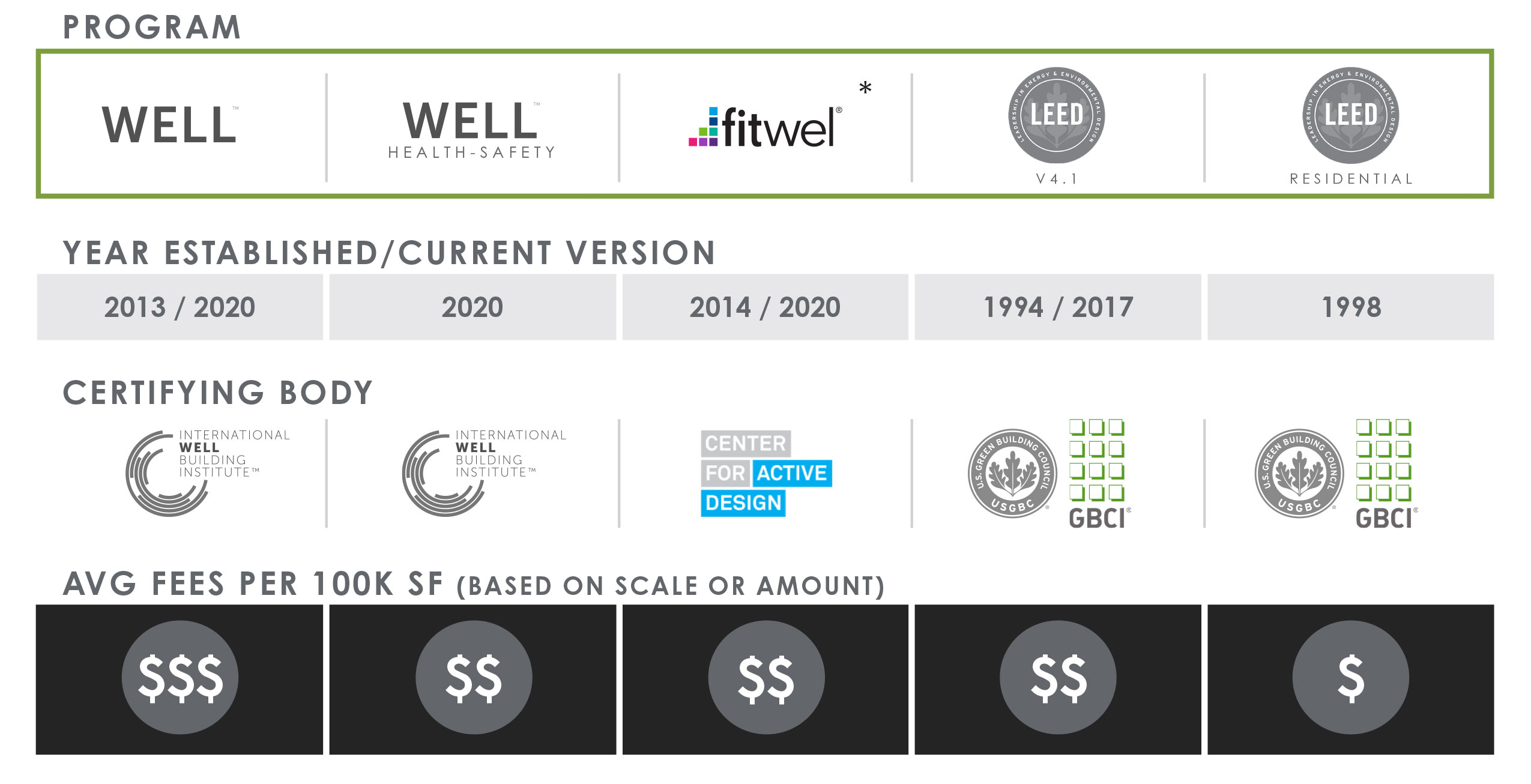
According to the Global Wellness Institute, the global wellness real estate sector was estimated at $134 billion and is projected to grow to $198 billion by the year 2022. The general public’s desire for healthy spaces in a post-COVID-19 world is likely to accelerate the need for healthy buildings across the board. Apartments, condominiums, and office buildings boasting healthy building or wellness-focused certifications may find themselves ahead of the competition. A building is a system, and change in one area creates a ripple effect throughout the rest of the structure. For example, the increase in building codes has tightened the envelope so much that it has had an adverse impact on indoor air quality. In the past, buildings were allowed to breathe and freely expend “used” air. Today, buildings should have intake and exhaust strategies to guarantee healthy indoor air quality including methods and means of controlling the source of pollutants, filtering out the pollutants or increasing ventilation. Studies have shown that healthy indoor air quality leads to fewer sick days and a more productive workforce.
Energy efficiency can save money, but at what cost to human beings? A recently published study found that allowing even minimum outdoor air ventilation levels reduced the transmission of influenza by 50% – 60%. Josh Allen, Ph.D., and assistant professor of Environmental Health at Harvard University, says that “The true cost of running our buildings should take into account the health and productivity of people in those buildings.” This is why owners and developers should be approaching their projects from a holistic and health-focused perspective, and consider the impact of a building on its future occupants. JSE has experienced, qualified consultants and engineers that understand the real-world costs of implementing these holistic strategies and balancing them with a project’s goals and budget.
Strategies, Industry Trends, and Upcoming Advancements for Sustainability and Healthy Buildings
There has been a significant increase in the desire for metrics surrounding wellness claims in the real estate market as of late. The lack of measurable data surrounding actionable, community-relevant metrics makes it difficult for developers and owners to target and promote healthy behaviors and outcomes in their projects, and to use this data to differentiate themselves from the competition. This trend is changing, however, as evidenced by the International WELL Building Institute’s investment of a television advertisement during the 2021 Superbowl. Policies & procedures, marketing campaigns, and new and improved rating systems are being exhibited more frequently regarding health and wellness within the community.
Focus on Environmental, Social, and Governance (ESG) is also seeing an upward trend. In the real estate market, this is primarily done through reporting tools such as the Global Real Estate Sustainability Benchmark (GRESB). The GRESB works to assess and benchmark ESG standards as more companies turn their attention to building a sustainable world for future generations. The GRESB Real Estate Assessment is the ESG benchmark for private property funds, listed property companies, investors, and developers. The GRESB collected self-reported data and then initiates a multi-layered validation process which is then scored and bench-marked. This gives investors high-quality data to be used in their decision-making processes. In 2020, the GRESB reported more than 1,200 property companies participated in this process, representing $4.8 trillion assets under management.
Building and Energy Codes in the United States have been evolving for decades. The first building code was created in 1625 and centered on fire safety and materials allowed for roof coverings. As time went on, advancements in technology led to increased stress on the environment. There was not always such a focus on reducing energy or water use inside a building, in fact, a focus on reducing energy and water consumption in buildings began with the Energy Policy Act of 1992. Creating Energy Codes yielded significant savings for the U.S. economy and reduced the strain on the United States’ power systems.
Today, a building is no longer considered just a building. It is its own community with many different elements and factors to take into consideration. Models are being used to predict water and energy consumption, with tracking of actual consumption using tools such as the EPA’s ENERGY STAR Portfolio Manager and GRESB (the Global Real Estate Sustainability Benchmark). In residential spaces, indoor air quality is improved by controlling pollutants, filtering them out, and increasing ventilation. Commercial buildings are focused on the latest advancements in HVAC technology, along with COVID-19 mitigation techniques.
You can’t talk about upcoming trends without mentioning the COVID-19 pandemic. According to Erin Bordelon, “We can’t predict the future, but we can see how COVID has impacted the way we think about buildings. Will something similar happen with healthy buildings and increase focus on indoor air quality? Will the building of the future have monitors to check occupants’ vital signs, vaccination histories or droplet projections for contract tracing?” Post-pandemic healthy buildings may include indoor air quality monitoring, testing, and filtration/cleaning measures, such as UV lamps and bi-polar ionization. It’s apparent that to increase the health and well-being of building occupants, more money needs to be spent on fans, filters, ductwork, chillers, heat exchangers, and dehumidifiers – and on the energy to run them. These extra costs are often offset by the increased productivity of workers in commercial spaces, and the happiness and overall well-being of those in residential buildings.
Rating Systems for Wellness Building Standards
Several groups have been formed to develop and provide a roadmap to healthy building standards. They work to guide building owners toward achieving well-rounded health and wellness goals for their structures. The four rating systems we focus on here are the WELL Building Standard, WELL Health Safety Rating, Fitwell, and LEED certification.
WELL BUILDING STANDARD™ VERSION 2 (WELL V2™)
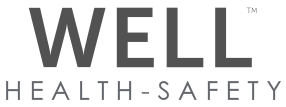
The WELL Building Standard™ is put forth by the International WELL Building Institute, also known as the IWBI. WELL version 2 was launched in 2020 and is the newest release of the WELL Building Standard. It is a comprehensive approach to health and well-being across ten concept areas: Air, Water, Nourishment, Light, Movement, Thermal Comfort, Sound, Materials, Mind, and Community. Each of these concepts is broken down into Preconditions required for certification, and Optimizations, which project teams can pick and choose from to earn points and achieve different levels of certifications. Depending on how many of these Optimizations are met, you can be certified at levels of Bronze, Silver, Gold, and Platinum:
WELL V2™ CERTIFICATION
| Total Points Achieved | Optimization Points Per Concept | Level of Certification |
| 40 pts | 0 | WELL Bronze |
| 50 pts | 1 | WELL Silver |
| 60 pts | 2 | WELL Gold |
| 80 pts | 3 | WELL Platinum |
WELL v2™ can be used for any type of building; however, due to the mechanical systems necessary to achieve certification, it is not recommended for residential buildings at this time. The average cost to certify a 100,000SF building is roughly $18,500 for enrollment and program fees and $12,500 for on-site setting fees, plus additional costs for consultants, testing, and other documentation. Recertification is required every three years.
WELL HEALTH-SAFETY RATING

The WELL Health Safety Rating came about as organizations responded to the COVID-19 crisis by upgrading their policies and protocols. A group of close to 600 public health experts, virologists, government officials, and other professionals was founded in late March of 2020 to support IWBI’s response to the global pandemic. They felt that a third-party designation was needed to help owners and operators navigate evidence-based best practices to mitigate the spread of COVID-19. The WELL Health Safety Rating is made from a subset of features from the WELL Building Standard, recognizing the efforts of owners and operators as they strive to prevent infectious diseases like COVID-19. Because it’s a third-party review process, the integrity and consistency are validated, thereby earning a WELL Health-Safety seal.
Going for full WELL Building Standard certification takes time and resources, but the WELL Health Safety Rating is a great entry point for pursuing full certification down the road. Because the rating is focused on features that mitigate the spread of common germs, it is a good option for all building types. The cost to obtain a WELL Health Safety Rating for a 100,000 SF building is approximately $6,700.
FITWEL
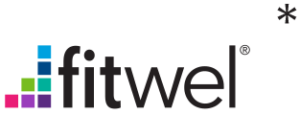
Fitwel was a collaboration among the Center for Disease Control, the U.S. General Services Administration, and the Center for Active Design (CfAD). It launched in 2017 and is managed by the Center for Active Design, a non-profit organization based in New York City. Fitwel is different from the WELL Building Standard in that there are no required prerequisites, but only optional credits. It’s built on the belief that buildings, both existing and under construction, can be improved to foster a healthy environment based on seven Health Impact Categories:
Each of these categories are broken down into 12 additional categories that make up a scorecard. For each approved measure or upgrade that is made, you earn a certain number of points. 90 – 104 points earns you a 1-star rating, 105 – 124 points equals a 2-star rating, and 125 – 144 points gets you the highest-ranking of 3-stars. Fitwel certification is good for any building type. The cost to obtain Fitwel certification for a 100,000 SF building is approximately $7,000, and certification lasts for three years.
*FITWEL & Design is a registered trademark of the U.S. Department of Health & Human Services (HHS). Participation by The Center for Active Design and/or any other organization does not imply endorsement by HHS. Outside the United States, the FITWEL service marks are owned by the Center for Active Design, Inc.
LEED V4
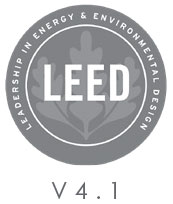
LEED Certification is run by the GBCI, or the Green Business Certification, Inc. The LEED rating system is different from the others in that LEED focuses more on buildings, whereas WELL and Fitwel focus on people. To qualify for LEED certification, a building must meet very specific, evidence-based standards to show a reduction in the amount of energy and water it consumes. It’s also important to show that the building was constructed using sustainable building practices to reduce the use of natural resources and divert landfill waste. There are different LEED certifications for different types of buildings, but almost any type of building can be LEED certified. The average cost for LEED v4 certification is about $7,500 for a 100,000SF building, and certification lasts for three years.
LEED RESIDENTIAL V4.1
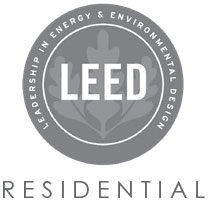
LEED v4.1 Residential certification is a simplified methodology for use with single-family and multifamily homes. In the past, developers were often confused about which requirements they should satisfy for certification, as they were only able to choose from mid-rise, high-rise, or new construction certifications. However, Green Business Certification, Inc. believes that all buildings, especially homes, should be green buildings, and recognizing such developed a simple and streamlined approach focusing on those issues that would have a higher value to a homeowner, such as energy and water savings, improved comfort and the use of green building materials.
Partnering with JSE to Pursue Wellness Focused Certification
The Jordan & Skala Engineers Sustainability Team is a group that focuses solely on assisting building owners to achieve certification for green building and wellness rating systems. We take the time to understand what the driving force of the project is (budget, performance, corporate messaging, investment/equity requirements, etc.) and find the right rating system to meet the goals of the project. The challenge lies in understanding each unique project, client, and building thoroughly so that we can assess and recommend strategies to achieve those goals. JSE’s Sustainability team has the knowledge and desire to not only evaluate the various certification and rating systems available but help our clients choose the right system to fit their needs.
Whether the goal is to achieve a specific certification or explore all available options in one particular facet of health and wellness, Jordan & Skala Engineers understands the importance of achieving a balance that works for you.
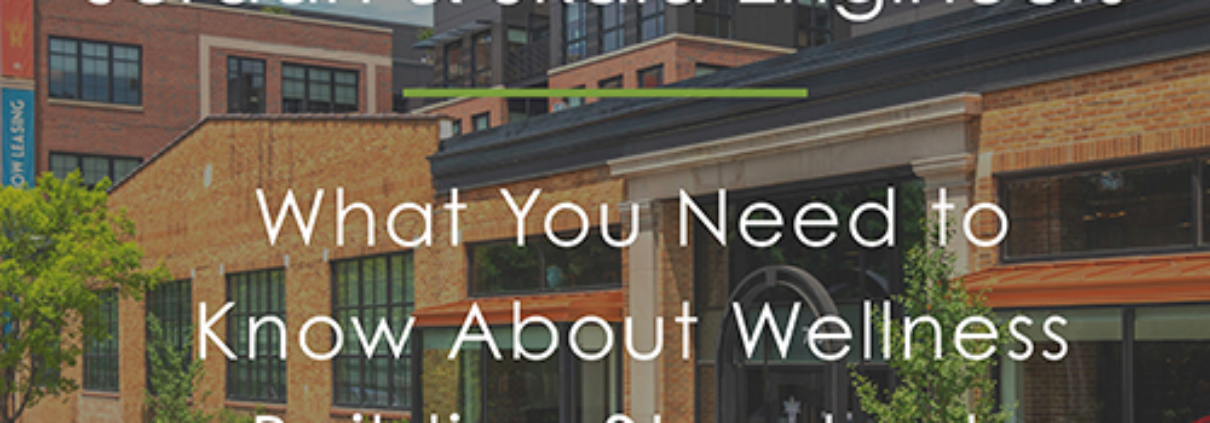
Leave a Reply
Want to join the discussion?Feel free to contribute!